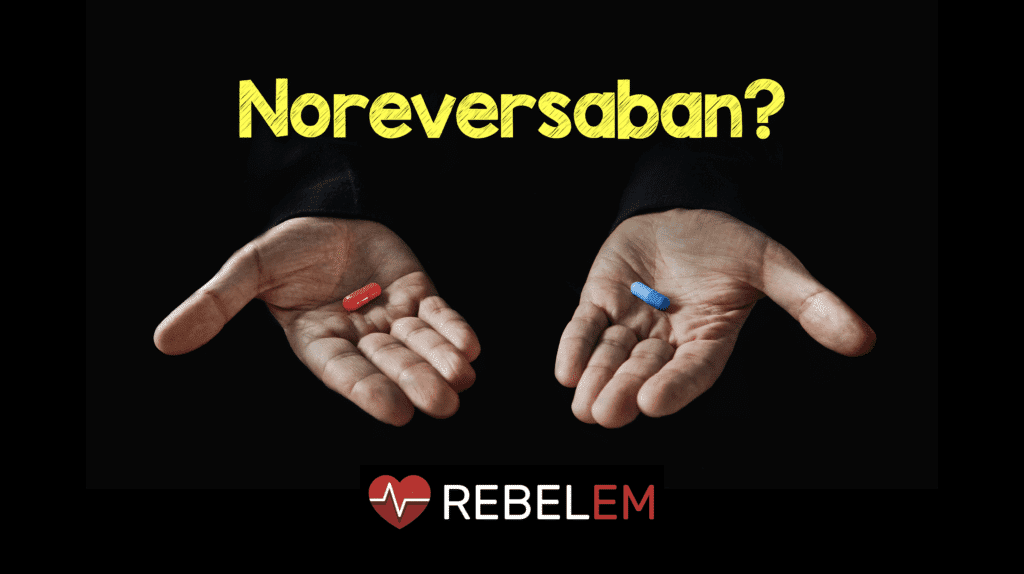
There is a game changing drug, Idarucizumab, now FDA approved as of October 16, 2015 for the reversal of the new NOAC Dabigatran. Lets take a look at the drug, its road to approval, and what evidence we are dealing with to date. At the end, we will give you a skeptical, evidence based evaluation and balance it with a humble commitment to how we would move forward given the data in true REBEL style.
Idarucizumab was developed by Boehringer Ingeleim. Yes, the same company that brought us Dabigatran, its intended target. They are trying to tame the very beast they created. Its kinda’ like the dentist who sells candy out of the candy shop beside his or her dental practice that will then gladly treat your cavity. Quite a lucrative business model? It is being marketed with the trade name “Praxbind “ to be used for reversal of Pradaxa, the brand name for Dabigatran. Idarucizumab is a direct antibody to Dabigatran, which renders it inactive. This antibody is some 300 times more attractive (binding affinity) to Dabigatran than thrombin, Dabigatran’s intended clinical target for anticoagulation.
This drug was first tested out on 236 healthy volunteers that were not taking Dabigatran in two studies and found to have negligible side effects [1][2]. It was then given to 47 healthy male volunteers who were first loaded with Dabigatran and then given the reversal agent Idarucizumab. They monitored a whole host of blood and drug levels and found that Idarucizumab reversed the most meaningful lab values in minutes, publishing results in the Lancet this summer [3].
Next, the RE-VERSE AD study by Pollack et al, started enrolling patients in an ongoing, multicenter, international, prospective cohort study [4]. They published preliminary, early results this summer in NEJM after enrolling 90 patients (average age of 76 years) who were taking Dabigatran mostly for A-fib (86/90) and divided them up into two groups. The primary endpoint was reversal at 4hrs post infusion using Dilute Thrombin Time and Ecarin Clotting Time and a secondary outcome of clinical hemostasis.
They divided the 90 patients up into 51 patients in Group A with life threatening bleeds (the ones we care most about) and 39 in Group B with non life threatening bleeds. Of the 51 patients with life threatening bleeds, they were only able to assess laboratory coagulation parameters in 40 patients (11 patients, at the point of initial inclusion, had sub therapeutic Dabigatran levels). At 4 hrs, 100% of patients with life threatening bleeds were reversed by Idarucizumab and most had normalization of lab parameters within 30 minutes.
There were only 35 of 51 patients that could undergo evaluation for ongoing clinical bleeding, the secondary endpoint. Many had intracranial hemorrhage, retroperitoneal or GI bleeding to name a few. They could not do serial hourly CTs or endoscopy to detect real time cessation of bleeding and therefore could only comment on clinical bleeding cessation in 35 total patients. This is really what we care about. In this group it took on average 11.4 hrs to reach clinical hemostasis.
It should be noted that the half life of Dabigatran is 12-14 hrs in patients with normal renal function. 11 hours is much longer than we would hope to see an “antidote” work for hemostasis. Would they have bled as long without Dabigatran on board? Would patients on therapeutic Dabigatran have bled as long without administering the proposed antidote Idarucizumab? This study did not answer these questions.
Of the 51 life threating bleeding patients, nine died, three of them from bleeding. The others died of forms of respiratory failure and one of “general health deterioration” (whatever that means). Since there was no comparison group, the results cannot be judged to be equal or superior to other existing expert recommendations that currently exist such as 4 factor PCC, aPCC (FEIBA) or placebo [5][6].
Complications from this reversal agent were reported to be low. The data from the healthy volunteer study seemed to show a low side effect profile with no patients having any serious adverse events from Idarucizumab infusion in any of the studies. Post reversal thrombosis occurred in five patients.
The Good:
- The hypothesis of an antibody binding antidote seems to be philosophically safer than trying to balance anticoagulation drugs with the infusion of hypercoagulable therapies. Hypothetically speaking, although not formally proven, this antibody may have less thrombotic complications than more thrombotic reversal options of coagulation complex concentrates such as PCC and aPCC.
- We like that it was done in actual patients in the population we are interested in studying.
- Being a multicenter and international study is good, and adds a component of diversity which makes the results more generalizable.
- The side effects of Idarucizumab seem to be low in healthy volunteers and in the cohort of actively bleeding patients.
The Bad:
- Significant bias. The same company who makes the drug Dabigatran is also the same company producing the proposed antidote Idarucizumab. The Glund and Pollack studies were industry sponsored and conducted by investigators with a myriad of conflicts of interest.
- This study is vastly underpowered. The small numbers of enrolled patients is hard to create the level of evidence that would warrant a major change in clinical practice. If we only look at the life threatening bleeding patients, we are left with 51 patients. Then remove the 16 that they were unable to assess clinical bleeding, we are left with 35 patients. These are small numbers. More enrolled patients would be nice to see.
- This study was a prospective cohort study that was not blinded and not randomized or compared with other treatment modalities to see if in fact the proposed therapy under question is superior to other therapies or placebo.
- 11 patients had sub therapeutic levels of Dabigatran upon arrival that should have been excluded from the study. Including these patients could falsely over-inflate the results of the study.
The Truth:
We can say that Idarucizumab hypothetically shows promise as being a potentially good strategy for reversing Dabigatran in patients requiring reversal. Based on the existing limited data, it seems safe to administer to patients. Reversal of Dabigatran by Idarucizumab must be studied in larger numbers of patients by unbiased investigators and in comparison to other competing strategies recommended by expert panels before it can be deemed the hands down reversal agent of choice for Dabigatran. Further work needs to be done to bring the level of evidence beyond what we judge to be level C. Based on this level of evidence we can only give this a IIb recommendation. Then again, the competing strategies and evidence for management of the life threatening bleeding patient on Dabigatran are equally if not less convincing and promising than Idarucizumab.
Clinical Bottom Line: For now, if we had to choose to give this medicine to a loved one who was needing emergent reversal for a serious life threatening bleed, we are between a rock and a hard place. We may be forced to use this therapy despite limited evidence at this time.
References:
- Glund S, Moschetti V, Norris S, et al. A randomised study in healthy volunteers to investigate the safety, tolerability and pharmacokinetics of idarucizumab, a specific antidote to dabigatran. Thromb Haemost 2015;113:943-51. PMID: 25789661
- Glund S, Stangier J, Schmohl M, et al. Idarucizumab, a specific antidote for dabigatran: immediate, complete and sustained reversal of dabigatran induced anticoagulation in elderly and renally impaired subjects. Blood 2014;124:344. [Abstract]
- Glund S, Stangier J, Schmohl M, et al.Safety, tolerability, and efficacy of Idarucizumab for the reversal of the anticoagulant effect of dabigatran in healthy male volunteers: a randomised, placebo-controlled, double-blind phase 1 trial. Lancet 2015 June 15. PMID: 26088268
- Pollack CV et al. Idarucizumab for Dabigatran Reversal. N Engl J Med. 2015 Aug 6;373(6):511-20. doi: 10.1056/NEJMoa1502000. Epub 2015 Jun 22. PMID: 26095746
- Siegal DM, Cuker A (2013) Reversal of novel oral anticoagulants in patients with major bleeding. J Thromb Thrombolysis 35(3): 391–398. PMID: 23389753
- Siegal DM. Managing target-specific oral anticoagulant associated bleeding including an update on pharmacological reversal agents. J Thromb Thrombolysis. 2015 Apr;39(3):395-402. doi: 10.1007/s11239-015-1167-9. PMID: 25586208
For More on This Topic Checkout:
- Ryan Radecki at EMLit of Note: Let’s Reverse – Dabigatran
- David Slessor at The Bottom Line: Idarucizumab for Dabigatran Reversal
- Ken Milne at The SGEM: SGEM#139 – One Thing Leads to Another – Idarucizumab for Dabigatran Reversal?
- Dan Silva at CORE EM: Idarucizumab for Reversal of Dabigatran
Post Peer Reviewed By: Matt Astin (Twitter: @mastinmd)



